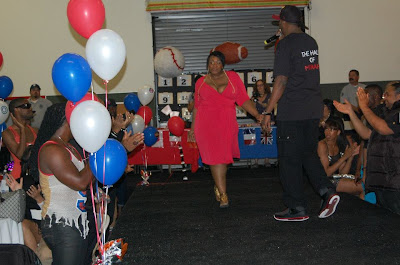KIKI Ballroom Scene: An organically grown community
intervention created in late November of 2002 during an Annual
Thanksgiving Dinner held by the House of Latex Project. Iconic Aisha Diori Latex Prodigy current Assistant Director Of Health & Wellness at the Hetrick Martin
Institute and the late Legendary Arbert Santana created the Kiki scene as an
empowerment and prevention tool to target LGBTQ youth and young adults involved
in the mainstream House Ball. The Kiki scene is collaboration between HIV/STD
Prevention workers and youth collaborators to empower youth & young adults
in the ballroom community. The Kiki scene is a replica of the mainstream
ballroom scene but 80% of the time it is tied into a prevention based
organization which gives the scene it’s own unique spin. Members of Kiki scene
often comprise of current mainstream ballroom members and youthful newcomers
(who may not be in the mainstream scene). The Kiki scene has modeled itself
into a quasi ballroom social scene with its own houses, balls and status
structure.
Aisha Diori saw that there was a need for an intervention
that reached out directly to the Youth & Young Adult members in the
mainstream ballroom community. A core ideology of the Kiki scene is the
utilization of the Peer driven subculture specific model which replicates key
concepts for the TEACH Evidence Based Intervention program which she graduated
from in 2004. The sole mechanism of the Kiki based programing is to provide a
safe space for social and creative work away from negative influences and
unhealthy social/familial distractions. The intervention also bridges
connectivity to educational and job readiness options, connecting
program participants to youth created HIV/STD prevention messaging,
facilitating referral if needed for psychosocial and mental health needs,
preventative care via HIV/STD testing and connection to medical care. The
program is designed to enhance community building and positive interactions
through peer support and accountability.
HOUSES, STRUCTURE & STANDARDS
Kiki Houses are organized as family units and comprises
of current mainstream ballroom members and youthful newcomers (who may not be
in the mainstream scene). These houses operate independent of the mainstream
scene and have their own names, although the structure is familial like in the
mainstream and has leaders (often mother and father) and “children”. There are
approximately about 1,000 + Kiki Affiliated Youth & Young Adults
involved in the scene and there are a countless amount of spectators and age
range from 12-25 and are predominately LGBTQ Youth and Young Adulta of color. The Kiki
scene’s main houses were founded in the New York City Metro Area but are been
replicated in other Major US cities and internationally in Canada and Japan. A
few Kiki Houses of them have the same name as mainstream houses although they
are not affiliated with them. Bellow you will see a list of the current Kiki
houses, but with the adaptability and creativity of the leaders and new cohort
there are sure to be more house added onto this list a the scene evolves.
1. CARTIER (not affiliated with mainstream house of the
same name)
2. CIROQ
3. DEZIRE
4. ECLIPSE
5. ELITE (not affiliated with mainstream house of the
same name)
6. GALLIANO (not affiliated with mainstream house of the
same name)
7. JUICY COUTURE
8. LOUBOUTIN
9. OLD NAVY
10. PINK LADY
11. PUCCI
12. UNBOTHERED
13. XPRADAGANZA
THE FIRST 2 KIKI HOUSES CREATED IN 2003
LIPTON & D-BLOCK
GLOSSARY OF KIKI BALLROOM TERMS:
KIKI HOUSE: A group of youth who get together to
mimic a family structure, which includes a mother, a father, and house
children. They collectively empower, mentor and participate competitively in
events called Kiki functions.
A BALL: A competition-based event that showcases
various fashion/talent categories utilizing the framework and culture of
pageantry. Participants compete for trophies, gift cards or cash prizes
depending on the event promoter. The categories include Runway, Face,
Best Dressed, Realness, Voguing and much more.
COMMENTATOR: A designated host or emcee for the
event that maintains the order of the function by facilitating the contestants
and categories, as well as engaging the spectators in mild banter. This person
is encouraged to use the power and influence of the microphone to spread safer
sex and prevention messaging.























